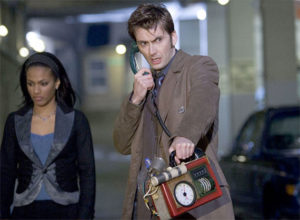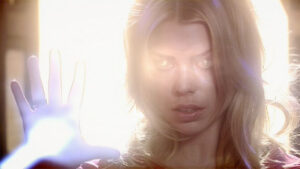Comparing the Different Arcs of the Revival
Guest contributor Holly Illis examines the arcs from each era of New Who.

I don’t think the RTD vs Moffat debate (*cough* argument *cough*) will ever really stop, not until this generation is dead, which is a cheerful way to start an article. I’m not here to pick a side (well, I’ll try not to), I just want to examine the advantages and disadvantages of what I think is one of the main differences in the two eras – story arcs. The ones that only last a series (Bad Wolf, Saxon, the bees/planets disappearing), and the ones that span three years (the crack in the wall, Silence will Fall.)
One of the biggest criticisms of the RTD era is the romance, the “soapy” element. And the fact that RTD’s story arcs only lasted a series, and weren’t really developed until the series finales, allowed more room for this “soapy” element. So if you don’t like the romance, you’re probably going to be against the series-long arcs.
 The arc lasting only a series really allows us to understand a character better, understand motives, and feel more sorry for them when they reach an inevitably sad ending (with the exception of Martha.) Take Donna. She started off as a temp, her mum was constantly on her back, she had no confidence, thought she was useless, and over the course of 13 episodes she developed, and her friendship with the Doctor showed her that she was incredibly important.
The arc lasting only a series really allows us to understand a character better, understand motives, and feel more sorry for them when they reach an inevitably sad ending (with the exception of Martha.) Take Donna. She started off as a temp, her mum was constantly on her back, she had no confidence, thought she was useless, and over the course of 13 episodes she developed, and her friendship with the Doctor showed her that she was incredibly important.
And what actually happened in that series? In Partners in Crime Donna mentioned in passing the bees disappearing, in The Unicorn and the Wasp she muttered “1926, they’ve still got bees”, and then nothing, right up until the finale. And for me, the fact that we weren’t concentrating on bees, or darkness, we were concentrating on Donna, made the ending even sadder. We had seen Donna grow as a character, and gain confidence in herself, instead of focusing on a complex plot that was forever referring to a mysterious far off resolution. She had so many different sides to her character, and then everything, everything she had done and learned about herself was wiped from her memory. And in the end, the whole thing had nothing to do with the bees! I know The Stolen Earth/Journey’s End is quite a controversial double, but I found that the fact that it didn’t really have much of a build up in no way took away from what I think is a fantastic story and an incredibly sad ending.
 Now compare Donna to Amy. By the time we got to Asylum of the Daleks, I really thought I knew Amy. She was a good character, properly developed, and I thought I could generally understand her. Halfway through series 6, it was revealed that she had been kidnapped so that Madame Kovarian could use her baby to kill the Doctor – something that was resolved two whole years later. At the time, I didn’t think Amy having a big part in this story really took away from her character, but what happened at Demons Run meant that she could never have children again. And now we go back to Asylum of the Daleks, and because she is not able to have children, she splits up with Rory. What? Where did that come from? I thought that that was completely out of character and totally unnecessary. I just could not understand why she did that and it really stuck out as something un-Amyish, just so that Asylum of the Daleks could have a bit of extra plot.
Now compare Donna to Amy. By the time we got to Asylum of the Daleks, I really thought I knew Amy. She was a good character, properly developed, and I thought I could generally understand her. Halfway through series 6, it was revealed that she had been kidnapped so that Madame Kovarian could use her baby to kill the Doctor – something that was resolved two whole years later. At the time, I didn’t think Amy having a big part in this story really took away from her character, but what happened at Demons Run meant that she could never have children again. And now we go back to Asylum of the Daleks, and because she is not able to have children, she splits up with Rory. What? Where did that come from? I thought that that was completely out of character and totally unnecessary. I just could not understand why she did that and it really stuck out as something un-Amyish, just so that Asylum of the Daleks could have a bit of extra plot.
I’m rambling. The point is, I think if we’re not tied down by a long plot line, we can get to know characters better and they won’t do something completely out of character.
 The other main advantage of series long arcs (that aren’t really built upon) is that, in my opinion, they allow the writers to focus solely on fantastic individual episodes without having to link them to the arc. Here’s an interesting fact: in the recap of DWTV’s Series 1-7 face-off, I noticed that whenever one of Moffat’s episodes from the RTD era came up against one of his episodes from his era, the one from the RTD era always won. I think most people will probably agree that Moffat has never written an episode better than Blink, when he wasn’t focusing on an arc. I also absolutely love The Girl in the Fireplace, and his doubles were easily my favourite doubles from their respective series. In every case, they are self-contained stories, not linked to lengthy, convoluted arcs.
The other main advantage of series long arcs (that aren’t really built upon) is that, in my opinion, they allow the writers to focus solely on fantastic individual episodes without having to link them to the arc. Here’s an interesting fact: in the recap of DWTV’s Series 1-7 face-off, I noticed that whenever one of Moffat’s episodes from the RTD era came up against one of his episodes from his era, the one from the RTD era always won. I think most people will probably agree that Moffat has never written an episode better than Blink, when he wasn’t focusing on an arc. I also absolutely love The Girl in the Fireplace, and his doubles were easily my favourite doubles from their respective series. In every case, they are self-contained stories, not linked to lengthy, convoluted arcs.
While Moffat’s era has lots of stand-out episodes in the middle of the series (like The Doctor’s Wife, Vincent and the Doctor), I personally am hard pushed to find any as good as his from the RTD era, and other RTD era episodes, like Human Nature/The Family of Blood, Midnight… the list goes on. And while the hardcore fans are always important, I think the casual viewer is just as important, if not more so, and I think the RTD era probably appeals to them more.
However, years-long arcs undoubtedly have their advantages. For one story to last three years is quite a feat, and to do this it has to have so much potential, a great concept and loads of things to explore – pretty much all the advantages rolled into one. The series arcs, while highly entertaining and with their own advantages, are quite linear, and sometimes squashing their resolution into two episodes can be tricky.
 This is another main criticism of the RTD era – the deus ex machina. Trying to squash a big resolution into two episodes sometimes gives a writer no option but to finish with something completely unexpected. Sometimes this can work well – like in The Parting of the Ways, where Rose comes back having absorbed all the energy of the Time Vortex, giving her the power to destroy the whole Dalek fleet and resurrect Jack. At least this was mentioned earlier in the series – the Doctor does say that the TARDIS is a living thing, sort of telepathic, and in Boom Town Margaret Slitheen looks into its heart. And for most of The Parting of the Ways Rose is trying to break open the TARDIS, so it doesn’t come as a huge surprise when she arrives on Platform 1 able to save the Doctor.
This is another main criticism of the RTD era – the deus ex machina. Trying to squash a big resolution into two episodes sometimes gives a writer no option but to finish with something completely unexpected. Sometimes this can work well – like in The Parting of the Ways, where Rose comes back having absorbed all the energy of the Time Vortex, giving her the power to destroy the whole Dalek fleet and resurrect Jack. At least this was mentioned earlier in the series – the Doctor does say that the TARDIS is a living thing, sort of telepathic, and in Boom Town Margaret Slitheen looks into its heart. And for most of The Parting of the Ways Rose is trying to break open the TARDIS, so it doesn’t come as a huge surprise when she arrives on Platform 1 able to save the Doctor.
But then there’s Last of the Time Lords, and the Tinkerbell ending where the Doctor is restored to his original form by the whole of planet Earth wishing. I know that “I had a whole year to integrate myself into the Archangel network” but we had no warning of this ending, and it seems very rushed, because the resolution had to be fit into the last ten minutes or so of that episode.
While years-long arcs are definitely more prone to plot holes, they are less linear and keep you wondering, keep tugging you along, all building up to the climax, which, after three years, has to be massive. Some people think that The Time of the Doctor wasn’t a very good episode, but I don’t think there’s any denying that it was big. The Bad Wolf arc in series 1 was essentially us wondering what it is, oh it’s been mentioned again, what is it, what is it, what is it, oh that’s what it is, and on to the next arc. The crack and the Silence ran for years, and when we discovered that they were interlinked, it was quite a satisfying moment, finally resulting in the regeneration of the Eleventh.
In this article I’ve been trying to focus on just one element that separates the two eras, the difference in arcs, but it’s been difficult, because they are so different in so many ways. RTD and Moffat have very contrasting styles, and because of these styles, and their different approaches, it’s pointless in a way to have these endless debates, because it all comes down to opinion. Then again, the point of a debate surely is to try and persuade the other side to go with your opinion, so, er… as you were. If you can guess which era I prefer by the way, I’ll be very impressed, due to my total unbiasedness. (Sarcasm). And yes… ‘unbiasedness’ is a word.








